Generative AI (Gen AI) has evolved over the past couple of years from being a cost-cutting experiment to a powerful revenue generating engine. No more restricted to confined to automating mundane tasks, forward-looking enterprises are using Gen AI to create entirely new products, hyper-personalized services, and data-driven revenue channels.
For example, many retail giants are developing AI-powered recommendation engines that are trained to boost product bundles. Finance companies employ GenAI-based predictive engines for customized high-margin investment products. Likewise, healthcare institutions/organizations are implementing AI-generated simulations of clinical trials to speed up drug discovery while exploring better licensing opportunities.
Table of Contents:
According to an IDC study, US enterprises already integrating Gen AI across operations are reporting ROI multiples as high as 3.7, with leaders pushing beyond 10×—a clear indicator that AI is no longer a “support function” but a strategic profit lever.
The Pilot Trap – Where Most CXOs Are Stuck
Despite this potential, a majority of AI POCs remain stuck in pilot phase. Around 70% of organizations have successfully initiated Gen AI projects and even fewer than 25% have successfully taken those AI POCs to past the production stage and transformed them into revenue-generating use cases.
Do you know why less than 25% are able to do that?
Data fragmentation prevents them from developing a unified customer or product view.
Indistinct ROI metrics make it difficult to select revenue-impacting initiatives.
Legacy systems and compliance fears pull down integration into core business workflows.
Here’s what the leaders are doing differently:
Product innovation: Using GenAI to simulate customer feedback loops, design new product features, and reduce time-to-market by 30–50%.
Revenue-optimized personalization: Deploying real-time, AI-driven personalization engines that are driving 40–60% lifts in conversions for early adopters.
Data commercialization: Packaging proprietary datasets into subscription-based insights platforms, opening completely new business models.
Why Most Generative AI Monetization Investments Fail to Monetize
Generative AI holds enormous promise in maximizing roi, but most enterprises are failing to translate pilots into profits. According to Deloitte’s 2025 report, three out of four US enterprises have been successful in launching Gen AI initiatives, but fewer than 25% have scaled them into revenue-generating operations. The gap is not due to a lack of ambition or resources.
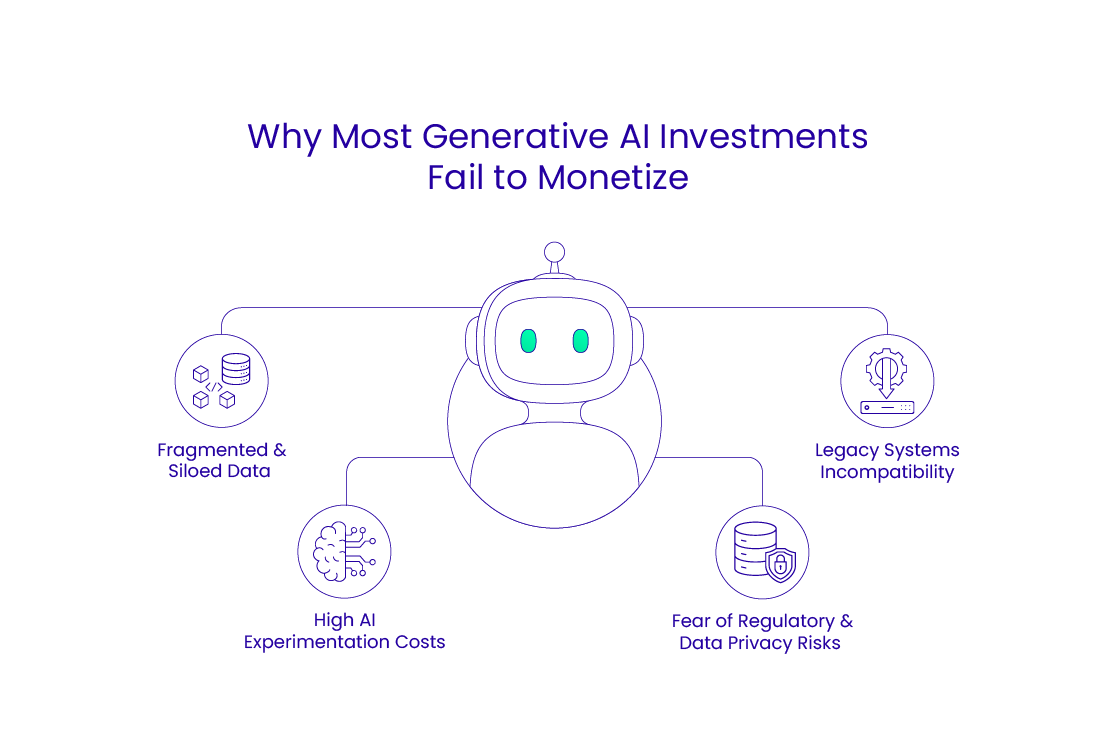
Fragmented & Siloed Data: No Unified Customer View
Data can be identified as the ‘fuel’ of Gen AI models. However, fragmentation is strangling its Generative AI monetization potential. Customer records sit scattered across CRM systems, marketing automation platforms, and legacy ERPs, making it impossible to create real-time, 360-degree customer profiles.
Without unified data, recommendation engines misfire with irrelevant product suggestions, dynamic pricing and hyper-personalized campaigns fail to scale, and predictive analytics remain theoretical rather than revenue-driving. Forward-looking companies are already investing in cloud-native data lakehouses and cross-platform integrations to eliminate these silos—a necessary step before any serious revenue impact is possible.
High AI Experimentation Costs with Unclear AI ROI Tracking
CXOs are under pressure to deliver returns, yet many GenAI initiatives are still treated as ‘innovation experiments’ rather than revenue investments. Millions are poured into POCs that generate impressive demos but no measurable financial impact.
The lack of ROI-driven KPIs—such as revenue uplift, margin expansion, or churn reduction—means CFOs struggle to justify scaling these programs. Early adopters who are winning have shifted to “ROI-first pilots”, where every AI use case in business is tied to specific revenue outcomes before a dollar is spent on development.
Legacy Systems Incompatible with Gen AI Workflows
Traditional enterprise systems weren’t designed for real-time data ingestion or GenAI-driven decisioning. This leads to slow, batch-based data processing that can’t support instant personalization or demand forecasting, high integration costs to retrofit AI into outdated infrastructures, and increased latency, making AI outputs irrelevant in fast-moving markets like retail and fintech.
Fear of Regulatory & Data Privacy Risks
With regulations like CCPA and upcoming US federal data privacy frameworks, many CXOs are hesitant to deploy Gen AI on a scale, fearing compliance violations. However, this caution is also costing them first-mover advantages.
Top-performing enterprises aren’t waiting—they’re investing in AI governance frameworks, automated compliance monitoring, and explainable AI models to both mitigate risk and unlock revenue opportunities before competitors catch up.
Recommended Reading:
- Generative AI, Real Returns — How C-Suite Leaders Are Turning Innovation into ROI
- Generative AI for Everyone: The No-Code Movement Powered by Snowflake
- Your AI Is Only as Smart as Your Metadata
- Role of AI Applications in Solving Business Problems Across Industries
- GEN AI Strategy to Execution – Build GEN AI – Powered Insights with Snowflake & AWS
- AI App Development with Snowflake: Understanding the Enterprise Shift to AI-Powered Applications
What It’s Costing Enterprises
For CXOs, every month stuck in AI generative experimentation translates into lost revenue opportunities. While competitors are monetizing data through advanced AI workflows, many enterprises are still running manual processes or rule-based automation. The cost of inaction is no longer theoretical, it’s measurable in millions.
Missed Cross-Sell & Upsell Opportunities
Without GenAI-driven customer segmentation and predictive analytics, enterprises fail to identify purchase intent signals buried in transactional and behavioral data. This leads to lost revenue from existing customers who could have been converted to higher-value product tiers.
Inefficient Marketing & Poor Customer Personalization
Marketing teams that still rely on manual segmentation and generic messaging are burning through budgets with minimal ROI. Without proper GenAI workflows, campaigns lack context-aware personalization, leading to declining email open rates and click-throughs. Marketing spend remains high because A/B testing cycles are slow and inefficient compared to AI-driven content generation and optimization.
Delayed Product Launches Due to Lack of AI-Driven Insights
In industries where speed to market defines competitive advantage, the absence of Gen AI is directly impacting revenue potential. Product teams relying solely on manual market research and traditional analytics face longer iteration cycles, sometimes adding 6–12 months to launch timelines.
Competitors deploying Gen AI simulations and predictive demand forecasting are launching faster, capturing early market share, and setting pricing benchmarks. A single delayed product launch in sectors like healthcare, fintech, or consumer electronics can mean millions in lost first-mover revenue and brand positioning.
Smarter Data Generative AI Monetization: The CXO Playbook
Forward-thinking executives aren’t treating Generative AI workflows as a back-office efficiency tool. They’re turning data into a profit engine—launching new revenue streams, personalizing at scale, and outpacing competitors in product innovation. Here’s how leading US enterprises are doing it:
Generative AI has enabled smart data monetization via various cloud-based solutions and AI-powered innovations. Through the combination of data from various sources, organizations can get better & faster actionable insights for customizing products & services and speed up their marketing strategies.
This has been made possible through the implementation of AI generative and cloud-based data lakehouses to cater to real decision making while generating prototypes and incorporate customized campaigns.
Let’s indulge in a deeper understanding of how GenAI results in smarter monetization.
Dealing with the huge volumes of customer queries and data is a herculean task. Traditional methods to analyze and find insights were time-consuming and made organizations stray off far in the competitive track. Generative artificial intelligence was designed to analyze data much faster and offer some relevant insights according to the requirements.
Consider the example of a US automobile company that incorporates generative ai for simulating & designing different vehicle models, acquire feedback via virtual test drives, and implement the same into developing better vehicle models or variants.
To sum, generative AI is gradually transforming how businesses are operating by facilitating them to implement data in a much better way for creating personalized customer experiences.
How to Get Started: Generative AI Monetization Roadmap for CXOs
Generative AI monetization is not cruising through the current technology road. It is about developing a ROI-focused roadmap that incorporates and transforms your data into revenue-generating assets.
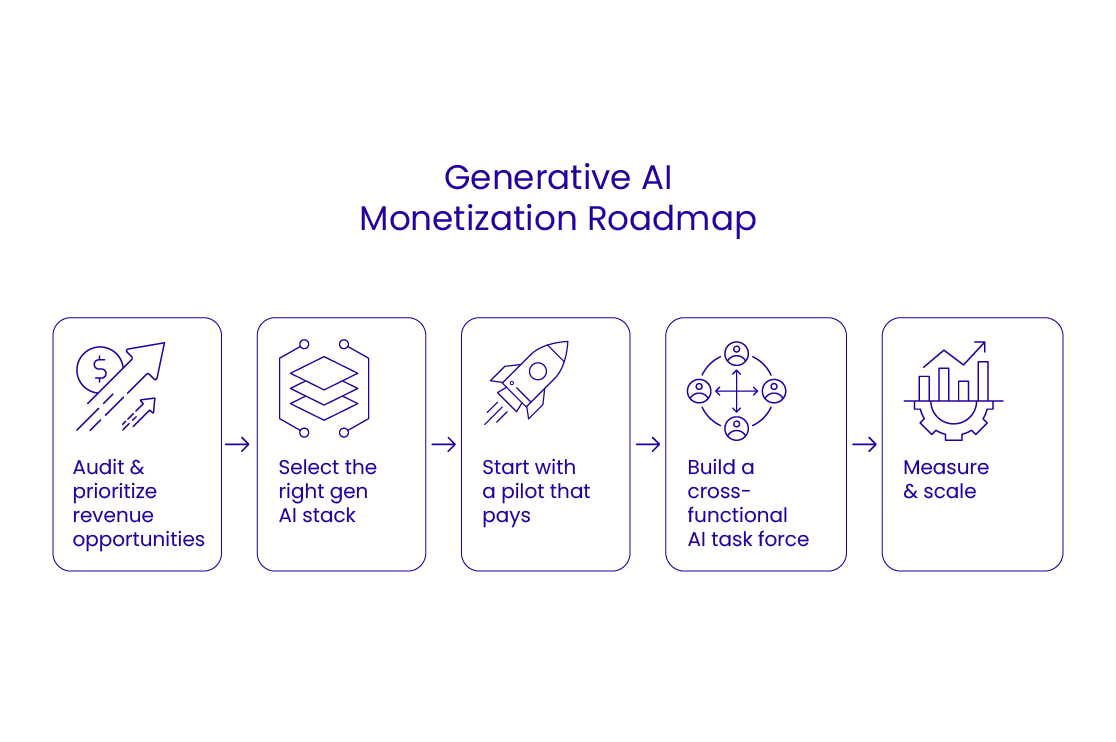
Here’s the 5-step CXO playbook to get started with:
Audit & prioritize revenue opportunities – Start off with performing an evaluation for understanding the revenue impact. Focus primarily on issues faced by customers where your use of GEN AI can deliver fast and visible resolutions with a win-win situation.
Select the right gen AI stack – Whether your business will get monetization opportunity or not is completely dependent on your technology stack. Snowflake is suited for real-time data sharing & analytics throughout different business departments, Databricks works well in situations that involve large-scale data lakehouses & advanced ML model training, and MS Fabric is suitable for end-to-end enterprises.
Start with a pilot that pays – If your Gen AI model is in the ‘pilot’ phase, ensure that it ‘pays’ rather that ‘stays’. Your generative AI model should work in your favor, not the opposite. Your AI model’s primary goal is to transform into a revenue-generating machine.
Build a cross-functional AI task force – As a CXO, monetization should not be a simple IT initiative. It should be top in the list of c-suite priorities. Develop a cross-functional AI team or force which should comprise of product teams, marketing & sales leaders, and data science & IT teams.
Measure & scale – Finally, set up a clear AI ROI tracking from the very first day. This tracking should include base metrics, use of real-time dashboards for monitoring overall performance, and focusing on only those use cases that exhibit a remarkable impact on revenue.
Conclusion
Generative AI is an absolute requirement for every business. The phase of “let’s wait & watch while we experiment” has gone. Enterprises that we see booming rapidly are not just incorporating the best Gen AI strategy; they are monetizing it in a much smarter way, resulting in better revenue-generating opportunities and capturing more market share.
For forward-looking CXOs, the mandate is clear:
Audit & prioritize revenue-ready use cases.
Invest in AI-ready data infrastructure & the right stack
Start with quick-win pilots that pay for themselves
Build cross-functional teams to execute fast and scale smarter.
Those who act now will define new pricing power, faster go-to-market cycles, and higher lifetime customer value. Those who hesitate risk being left behind in an AI-driven economy.
FAQs: What CXOs Ask Before Investing in Gen AI Monetization
How fast can I see ROI from Gen AI?ROI timelines depend on use case complexity and data readiness. Personalized marketing campaigns, recommendation engines, and dynamic pricing can deliver measurable revenue impact in 3–6 months.
Is my data ready for Gen AI revenue applications?Your data is “AI-ready” if it is unified, accessible, clean, enriched, and is easily available in a real-time basis. If all these conditions are met, your final AI model would become a tool for generating revenue. However, as a CXO, you should ensure that all the data-management tools, technologies, and platforms are in sync with your business requirements as well as the data.
What industries are seeing the fastest returns?There are several industries that have been experiencing rapid growth and strong ROI generation. IT, digital marketing, data science, and design are some of the key areas that have shown robust potential over the past few years. Industries like software development, e-commerce, online retail, healthcare, and IT services.
How do I ensure regulatory compliance while monetizing data?Compliance is & has always been a top concern for US CXOs. It is easily manageable with the right governance framework. Incorporate privacy-by-design architecture that syncs with CCPA and emerging federal AI regulations. Use explainable AI models to record decision-making logic as they are critical for audits.











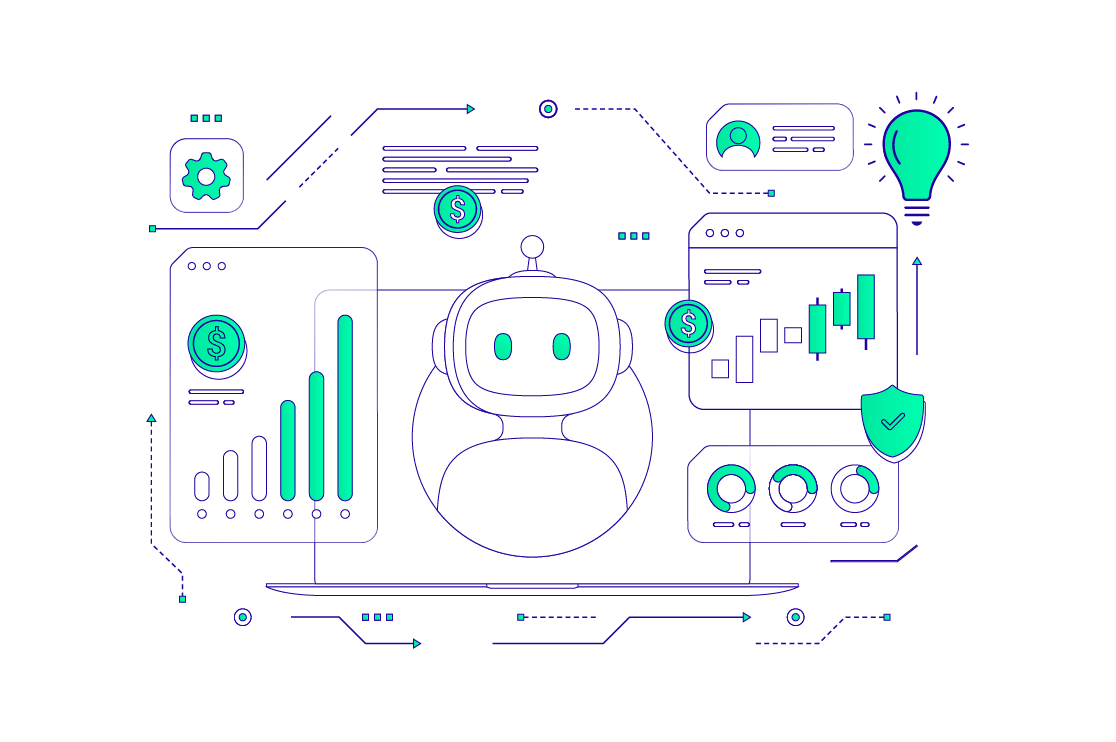
 AI Algorithms for Business Decisions: How They Deliver Real Value & Growth for CXOs
AI Algorithms for Business Decisions: How They Deliver Real Value & Growth for CXOs 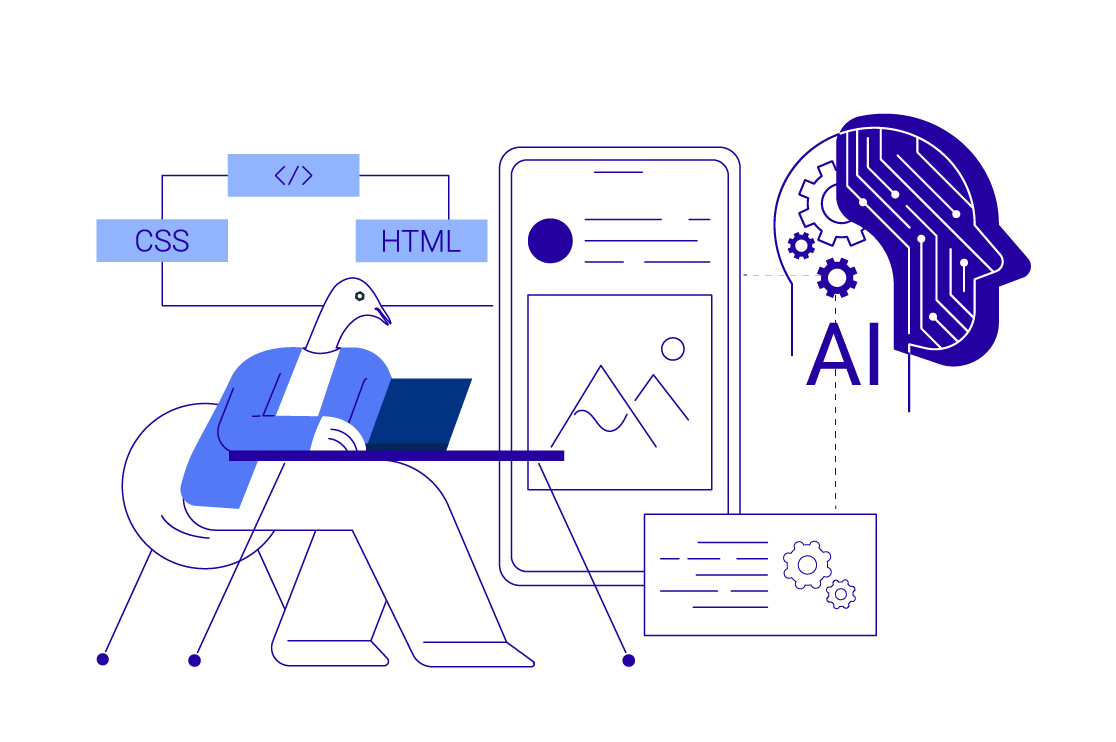 AI in Programming: Disruption, Evolution, and CXO Strategy
AI in Programming: Disruption, Evolution, and CXO Strategy 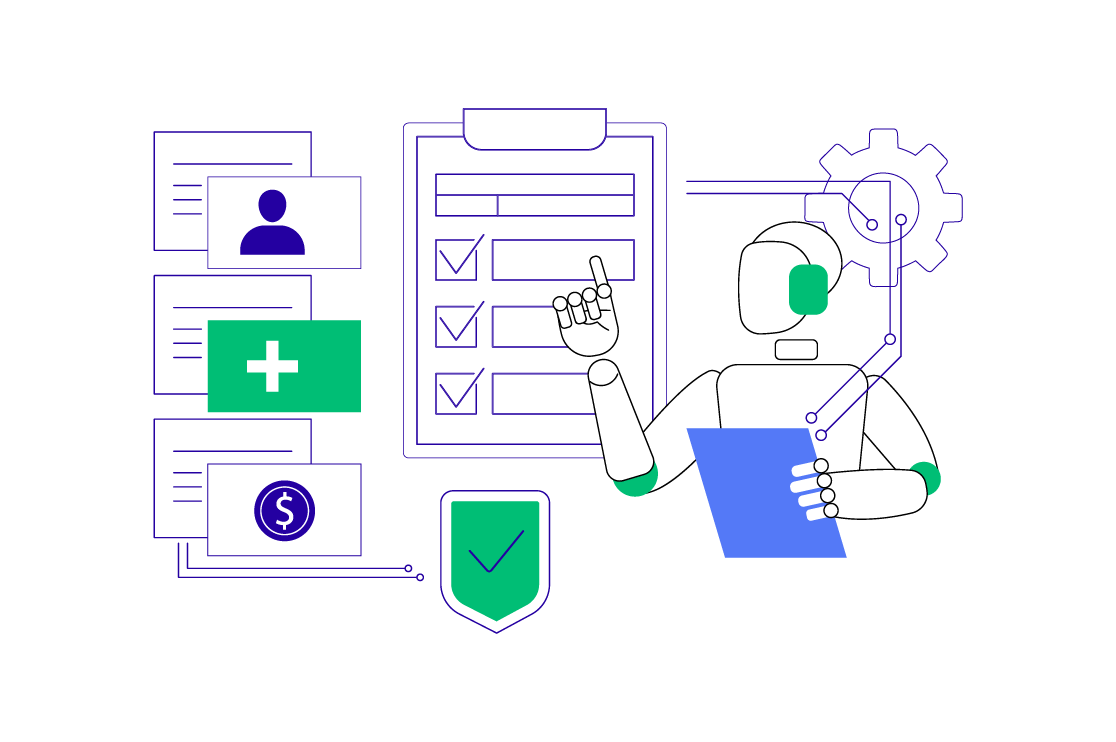 AI in Healthcare Administration: Cutting Costs & Boosting Efficiency
AI in Healthcare Administration: Cutting Costs & Boosting Efficiency 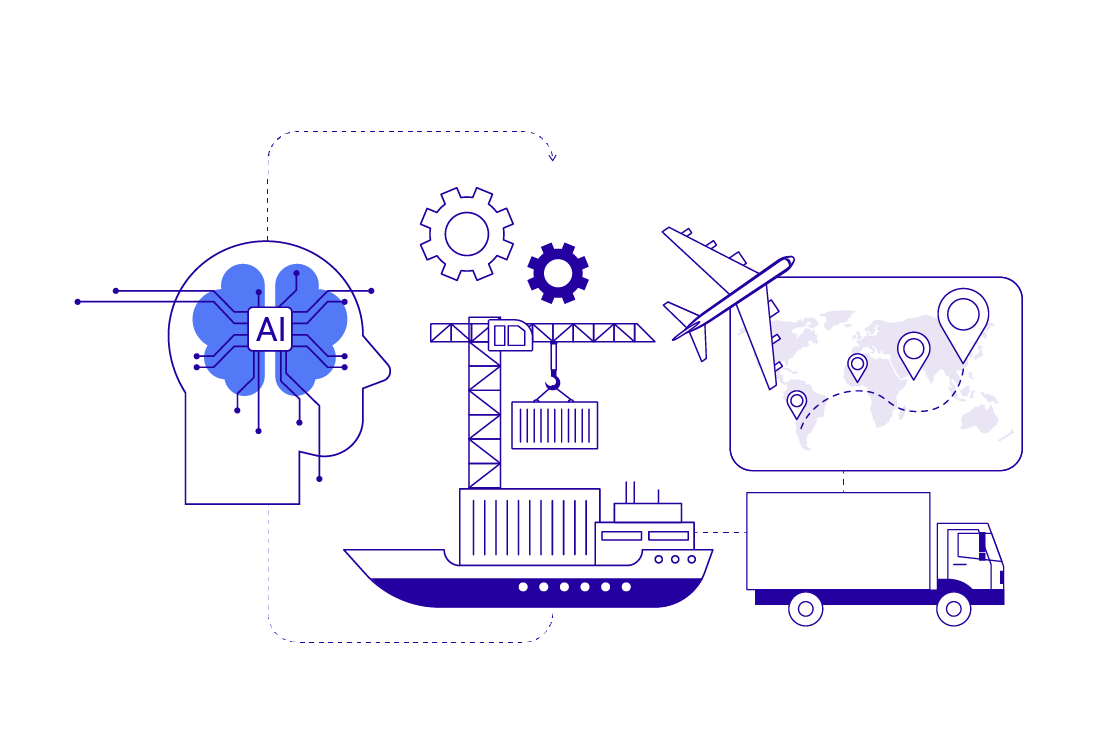 AI for Supply Chain Resilience & Optimization: Strategies for 2025 and Beyond
AI for Supply Chain Resilience & Optimization: Strategies for 2025 and Beyond 
